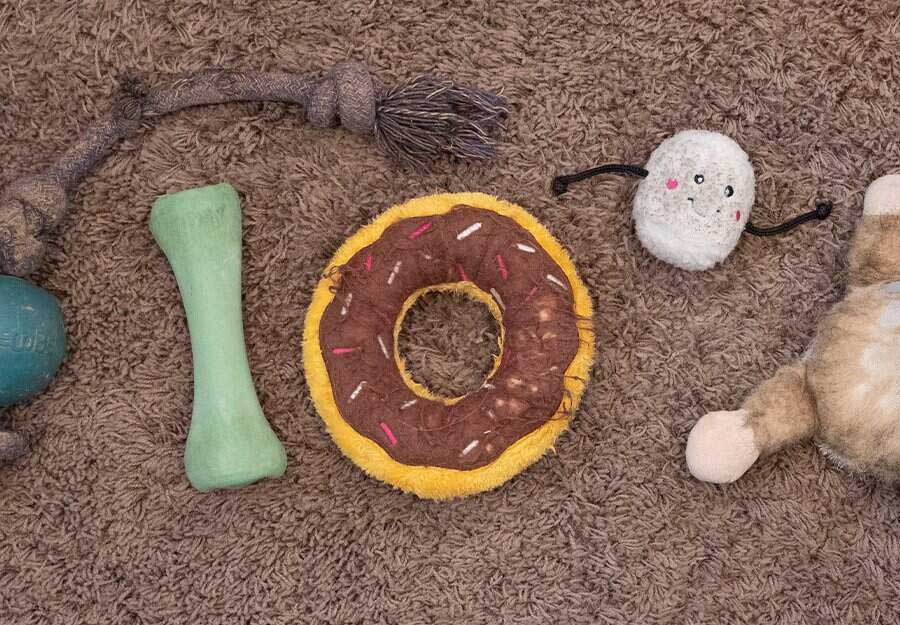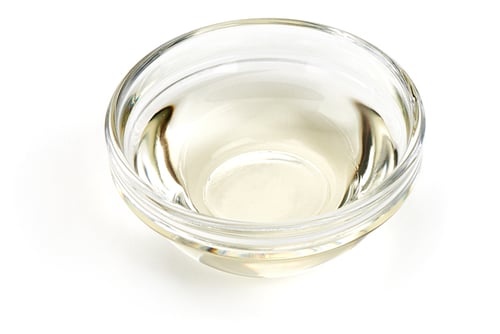
Most of us never think about cleaning dog toys, but this article will make you start. Learn how to clean your soft dog toys and keep yourself and your dog safer.
Your dog's toys spend a lot of time in their mouths, in the yard, at the park, in puddles, on their beds, and in many other places where dirt and grime can be picked up.
Let’s face it, your dog’s mouth is pretty gross. It’s full of bacteria, dirt, and whatever else they picked up on their adventures. The bacteria in their mouths don’t necessarily pose an imminent danger to us or them, but just think about how many dog toys are just accumulating bacteria, drool, dog food particles, and more.
We don’t often think about the cleanliness of our pets’ toys until we pick them up and realize how disgusting they look, smell, and feel. By this point, most of us would rather just throw that toy out and buy a new one rather than try to clean that ratty-looking thing.
That practice is definitely not cost-effective, and you may not realize the risk that this decrepit, germ-filled toy may pose to you, your family, and even your pet's safety if left to fester long enough. There is a better way, though.
So what's the next step? Learn how to wash dog toys safely and effectively.
Get into the habit of routinely cleaning your dog's toys, help keep them and yourself safer, and give your dog's toys a longer shelf life.
How Dangerous Are Dirty Dog Toys?
The good news is that the actual risk to your pet's toys from chewing on a filthy dog toy is not very high. Dogs are capable of handling a lot more bacteria than we are, so the risks to them are minimal and often cosmetic.
Have you ever heard of puppy acne? Contrary to how it may seem, puppy acne is rarely a result of hormonal changes or imbalances during their growth stages. It’s most commonly seen in dogs that chew on dirty toys, drink from unwashed dog bowls, and generally stick their muzzles in places with a lot of bacteria.
Dirt, oils, and bacteria can settle into the pores and hair follicles on their face, most often their chin area, which can cause irritation. This irritation looks like small red bumps, sometimes even pustules. Yuck!
Sanitizing dog toys and bowls and cleaning dog toys from the affected areas can lead to a quick reduction of ‘puppy acne.’ So long as dog toys and bowls are maintained, this condition is unlikely to return.
Learn more about preventing and treating your dog's pizza face in Dog Acne: 5 Tips for Healthy Dog Skin.
The real risk of dirty dog toys is to us. A little bit of dirt isn’t going to be a high-risk factor, but bacteria that have built up and festered on your dog's toys can be a little scarier.
You may not realize how often we come in contact with our dogs’ toys or the surfaces their toys have touched, not to mention the bacteria being carried and spread by your dog’s saliva and mouth.
Dirty toys can also break down faster. Depending on the material, even hard dog toys may start to weaken and be easier to break into pieces, posing a choking, ingesting, or puncture hazard. DIY dog toys are especially prone to breaking down, so keep them clean to prolong their life.
Regularly cleaning dog toys helps you thoroughly examine your dog's toys to determine if it is starting to come apart or if pieces are at risk of being chewed off.
Tips for How to Clean Dog Toys
Take a look at your pup's toy box. Wondering how to clean dog toys? Are there any dog toys that look kind of nasty? Would you be willing to pick up chew toys with your bare hands and then touch your hand to your face? Probably not, Right?
Here are some quick and simple cleaning instructions for your soft dog toys, tough dog toys, DIY dog toys and more:
Use a Natural Sanitizing Agent

Dish soap and commercial laundry detergent may do a good job of cleaning dog toys with a variety of materials and surfaces, but they can also leave behind a residue of the chemicals in the formula.
Considering this is something that goes in your pet’s mouth, you will want to avoid using cleaning products that are unsafe for your pet. Bleach, peroxide, and Lysol-type products are all on the no-no list.
Our top recommendation is to use white vinegar. It is a natural disinfectant, is safe to ingest, and is gentle enough not to damage the materials. Rubber toys, silicone, and nylon dog toys can be soaked in a 5% white vinegar and warm water solution for 10-15 minutes and then gently scrubbed with a clean sponge or brush to remove built-up dirt.
How to Wash Plush Dog Toys
For plush dog toys, you can toss a ¼ cup of white vinegar into your washing machine in place of laundry detergent and run the plush toys on a gentle cycle. Lay the plush toys flat or hang them to air dry, or use the no-heat, tumble cycle of the dryer to speed up the process.
Damaged and torn plush toys will further deteriorate in the washing machine and should be hand-washed to preserve them.
Fill the sink or a bucket with warm water temperature, and add an ounce of white vinegar. Gently scrub the favourite toy to loosen dirt, and rinse thoroughly to get rid of the sharp vinegar smell.
How to Wash Hard Dog Toys
Can you wash hard dog toys? Yes, you can. Plastic, rubber, nylon, and silicone dog toys can be scrubbed vigorously to remove dirt and grime.
Some rubber toys are dishwasher safe, making keeping them clean easier. It's a good idea to rinse dishwasher-safe dog toys to remove any soap residue.
Make sure to thoroughly rinse hard and rubber dog toys and air dry them before returning them to your pet’s toy bin. Moisture helps bacteria breed, so some dog chew toys may need to be left to air dry for a few hours.
Some toys are harder to clean than others because of their unique shape. Classic Kongs are notoriously difficult to reach all those nooks and crannies, so try a Kong Cleaning Brush.
Outdoor Toys Probably Need More Care

Having a set of outdoor toys and a separate set of indoor dog toys is quite common. If we think about the logic behind this, we don’t want the outdoor toys to end up on our couches, beds, or even the carpet.
We already know that our dog’s outdoor toys are stinky, and that’s why many of them have been banished to Backyardia, but keeping the dog toys outside doesn’t keep the germs out of the house.
Try to get into the habit of cleaning outdoor dog toys more often. Even cleaning one toy per week can significantly reduce the number of bacteria sneaking their way back into your home.
Because these toys get a little extra dirty, you may need to soak them a bit longer or scrub them roughly to clean them. For heavily soiled and settled grime, double the amount of white vinegar in your soak. Just make sure you rinse them well.
Rotate Your Dog's Toys
Try a rotation system for your dog's toys to make cleaning products easier. This way, you can have a set of toys in play, a set on deck, and a set being cleaned. Then you can make sure that you aren’t leaving your dog without anything to do while you wash dog toys and let them dry.
Toy rotation can aid in extending the life of the toys and prevent your dog from getting bored with them. Rotating toys once or twice a month will bring back that new toy excitement and keep your dog mentally active as he has to relearn how to play with that toy.
It will also prevent your dog from being too attached to any one toy. When you do need to lay a toy to rest, your dog won't be quite as distressed if they value all of their toys equally.
Be Excited When You Return the Toy

Washing dog toys also means removing the smells that your pet left on them. For some dogs, washing their go-to toy can be equivalent to washing your lucky socks. Your dog may feel that the toy's “mojo” is gone and may not show interest in the toy anymore.
How you reintroduce the toy can significantly affect your dog’s enthusiasm for it.
Don’t just toss the toy on the floor. Instead, try to make an immediate game out of it. If you are excited, it will help your dog get excited too. They are more likely to accept the toy if they see that you like it.
Don't Forget to Clean the Dog Toy Bin
How do you store your dog’s toys? In a toy bin? A basket? However, if you store your pup’s toys, know that the bacteria concentration in that storage container is pretty high.
You can clean those toys until the cows come home, but by putting them back in that disgusting container, they will continue to spread germs throughout your house.
Cleaning your dog’s toys routinely can be beneficial for everyone in your house. Toys don’t need to be 100% sanitized at all times, and a little bit of bacteria will likely not cause any harm, but having a system of reducing bacteria can make a bigger difference than you think.
Lastly, learn when to let go. It can be heartbreaking to throw away your dog's favourite toy, but some toys are just beyond saving. Retire it to the soft dog toys hall of fame if it can't be cleaned or repaired. Plus, that means a trip to the pet store to restock!
Frequently Asked Questions
Why is it important to clean dog toys regularly?
Regular cleaning of dog toys helps prevent the buildup of bacteria, dirt, and saliva, ensuring your pet's safety during playtime.
Can I clean all types of dog toys the same way?
No, different materials may require different cleaning methods. Hard toys can often be washed with soap and water, while plush toys may need a gentler approach, like spot cleaning or machine washing.
How often should I clean my dog's toys?
It's a good practice to clean your dog's toys at least once a week, but frequency may vary depending on how often your pet plays with them and their overall hygiene.
What cleaning products are safe for dog toys?
Use pet-safe cleaning products or a mixture of water and vinegar to clean most dog toys.
Can I use a dishwasher to clean dog toys?
Many hard plastic or rubber toys are dishwasher-safe on the top rack.
Are there any toys that can't be cleaned?
Toys with electronic components or those that can't be submerged in water may require special care. Read and follow the cleaning instructions provided with such toys.
.png?width=200&height=66&name=logo%20(1).png)





.jpg)
